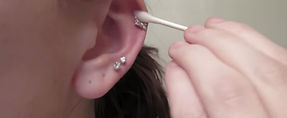Piercing Procedure
A fun experience the whole way through! All of our instruments and jewelry go through a thorough, step-by-step process to ensure sterility. All piercing stations and high-touch areas are wiped down with a high-grade disinfectant after each use.
Healing Successfully

1
Do not Play with or Constantly Move your new Jewelry
Number one issue is irritation. As your wound heals, it is creating a healthy layer of new skin. Moving your jewelry around can disrupt this process causing irritation, swelling and piercing bumps.
Spray/Soak and Go
Spray your piercing twice a day. If visible debris, soak first, then wipe clean with a cotton swab. Less is best. Spray and go.
2
Do not sleep on your fresh Piercing
Sleeping on a new piercing can cause irritation and unwanted movement. We suggest using an ear pillow if you have trouble avoiding the piercing side.
Sleeping on a piercing during healing can also cause migration on the angle of the jewelry as it heals. Leading to a slanted piercing.
3
Downsize your Post on Time
Downsizing refers to switching to a shorter post, once initial swelling has subsided (4-6 weeks). After this stage, the initial post is too long. Jewelry that is too long can snag easily and move around excessively, leading to irritation and renewed swelling.
This service is free, welcomed and highly recommended for successful healing.
• Surgical Steel is made of a variety of alloys. Many of them are used for body jewelry, but only a few specific grades are proven biocompatible: steel that is ASTM F-138 compliant or ISO 5832-1 compliant; ISO 10993-(6,10, or 11) compliant; or (EEC [European] Nickel Directive compliant.
• Titanium is a lightweight metal that is ideal for people with concerns about nickel sensitivity. This material can be anodized to create jewelry of different colors without affecting the safety. Look for implant certified titanium (Ti6Al4V ELI) that is ASTM F-136 compliant, ASTM F1295, ISO 5832-3 compliant, or commercially pure titanium that is ASTM F-67 compliant.
• Niobium has been widely used by piercers with good results for many years. It is very similar to titanium, but does not have an implant-grade designation. Like titanium, niobium can be anodized to produce different colors. (And, unlike titanium, it can be anodized black.) Anodized niobium and titanium may fade due to body chemistry or when worn in friction-prone areas, but this is not harmful.
• Gold (yellow , rose, or white) is appropriate for initial piercings if it is 14k or higher, nickel- and cadmium-free, and alloyed for biocompatibility. Gold higher than 18k is too soft for body jewelry because it can easily be scratched or nicked. Gold plated, gold-filled, or gold overlay/vermeil jewelry is not acceptable for fresh piercings. All of these involve coating a base metal with a layer of gold. The gold surface (which is very thin—measured in millionths of an inch) can wear or chip off.
• Platinum is a heavy precious metal that is extremely inert and excellent for wear in body piercings. However, body jewelry in this material is rare and very expensive due to the high cost of the material and greater difficulty in manufacturing jewelry from it.
• Glass—Fused quartz glass, lead-free borosilicate, and lead-free soda-lime glass are inert and considered safe for initial piercings. They can also be sterilized in an autoclave.
Common Healing Issues
There is usually an answer and a practical fix to saving your new piercing. Please educate yourself and always feel free to stop in the studio for help.

Piercing Bump vs Keliod
Piercing bumps are common compared to a keloid. They do go away. Click links to watch videos

Infection
Infection is rare, it is important to leave your jewelry in for the major healing process, which is typically 6-8 weeks. This will limit exposure of bacteria to the open wound-amongst other issues and irritations.

Over Swelling
We recommend you place a cold compress on your pierced area twice a day for the first three days. Come in for a longer post if you expiercence over swelling
.png)
Red and Tenderness
This is expected for at least the first 4-6 weeks after a piercing. If your new piercing is bumped or snagged, this can lead to excessive swelling and tenderness as well.

Oozing Fluid
A piercing is a puncture wound. Your body will naturally want to heal. Fluid is normal as it is attempting to form a scab to heal the wound.

Bleeding Intermittently
Each person can heal differently. Health and hygiene can play a role in how you heal. Remember, a piercing is a puncture wound that now has a "foreign" object that your body is healing around. Be patient and care for your piercing.
Videos On Jewelry Insertion and Removal
You will need a tool called a pin or threaded taper. We have them available at the studio



